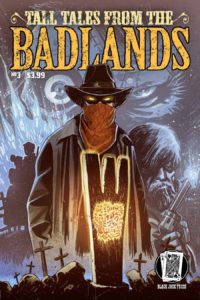 Tall Tales from the Badlands #3
Tall Tales from the Badlands #3
Publisher: Black Jack Press
Story: Mark Wheaton, Sean Fahey, Robert Napton, Matt Dembicki
Pencils: Jerry DeCaire, John Fortune, Franco Cespedes, Ezequiel Rosingana, Ruben Rojas
Inks: Jerry DeCaire, John Fortune, Franco Cespedes, Ezequiel Rosingana, Ruben Rojas
Letters: Kel Nuttall
The comics medium can encompass a wide variety of genres, from capes and cowls to spies, post-apocalyptic, science-fiction, fantasy, and horror, as well as one of the genres with a long history – the Western.
Westerns are, I would imagine, a tougher sell these days than they were back in the 1950s, or even back when I was growing up in the 1970s, when my friends and I would often play cowboys outside with our hats, boots, and six guns. Reruns of The Lone Ranger were still on TV after school, and our parents had grown up in the thick of the TV and movie westerns of the 1950s, and passed that lore down to us.
Currently, however, it would seem the western has fallen out of favor a bit, so it’s nice to see a small independent publisher like Black Jack Press keeping the genre alive with an anthology series they call Tall Tales from the Badlands. The first two volumes were more “straight” western in tone, while the subject of this review, the third volume, mixes things up by introducing a “Weird West” theme to its stories. While I actually enjoy the supernatural and horror aspects of the Weird West genre, being a fan of Jonah Hex and the old “Deadlands” role-playing game, I think in this case the anthology format isn’t suited to exploring this particular genre.
There are five stories in this collection, the shortest of which is six pages, and the longest of which is fourteen. In this short amount of space, there’s really not enough time to develop the characters, create the conflict, and then provide the supernatural twist ending that gives the setting a horror spin that ideally should be unexpected and come as a shock. In this case, though, given the set-up for this anthology, we know there’s going to be a twist ending, and since the stories are so short, the supernatural-tinged reveals come too quickly and are often telegraphed, so that one or two pages in, we can already tell how things are going to end.

That’s not truly a fault of any of the writers in this collection; rather, I think it was a missed opportunity to take some of the stories and develop them out into longer 22+ page stories, or even short mini-series. It would give us time to care more about the characters, so that when their demise comes at the hands of creatures from beyond the grave (or other supernatural types), we actually feel badly for them.
The lead story, by Mark Wheaton, comes closest to being a fully-developed story at fourteen pages in length. Even it, though, ends up being a bit choppy as it moves from scene to scene, as much of the background and segues have to be sacrificed for length. This is one story that could use a longer format to explore the background a lot more, to make the ending more powerful.
The other stories each show a kernel of an idea, and they do a decent job of emulating some of the old horror comics of the 1960s and 1970s, but many of the tropes are well-known by now, and again, the authors aren’t given a lot of space to work with to develop their stories. One story had a kind of interesting twist and borrowed liberally from the theme of M. Night Shyamalan’s The Village, but the story is over almost before it begins, and there’s really no sign that we’ll be seeing any more of those characters anywhere else, which is a shame, as I’d love to know more about how and why the characters got to where they are, and where they came from.
Similar to the writing, as an anthology series, the art varies widely from story to story. Everything is in black-and-white, but we get a mix of standard pen-and-ink line work, to detailed gray-scale coloring. Styles vary also, of course, from the almost cartoon-like figures of John Fortune in the short-story “Apologies,” to more realistic art from Ezequiel Rosingana in the story “All Mine.” Overall, the art is pretty good. For Franco Cespedes’s work in the story “Rustlers,” I would have preferred a bit more attention to the inking. There is no cross-hatching or shading here – everything is stark black-and-white, and the blacks are very minimal – basically, they’re only used for shadows and nothing else. There’s just not a lot of depth to the panels, which is unfortunate and a disservice to Cespedes’s penciling work, which is otherwise quite good.
I applaud Black Jack Press for keeping the western genre alive with a series of anthologies. The book is currently out and available in print format from Indy Planet, and digitally from a variety of resources including DriveThruComics. The publisher also offered a 100% money-back guarantee on the sale of all of their print books from Indy Planet.
Review copy provided by Black Jack Press.
Martin Thomas
@comicattack.net



